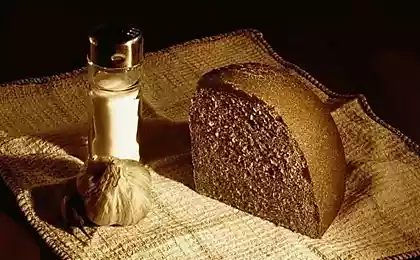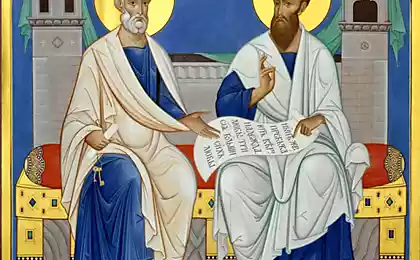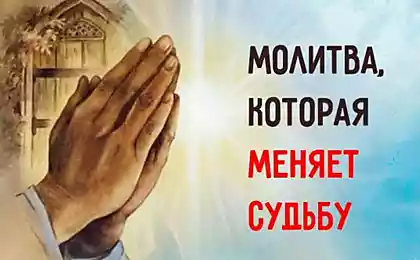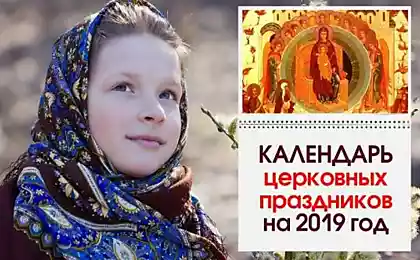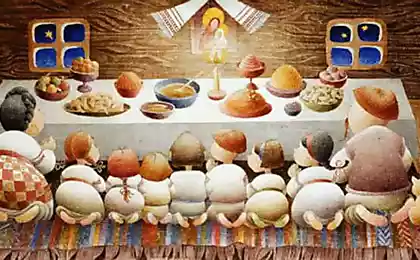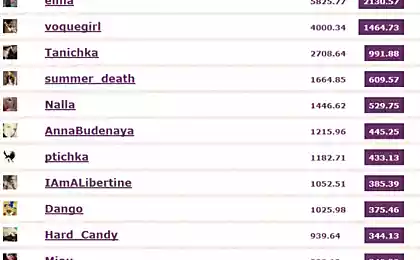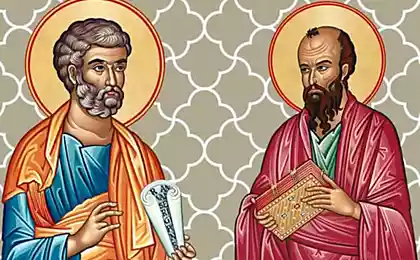703
Great post — the most important and severe among the posts
GREAT POST
“What is lent? It is a precious gift to us of our Savior, Who Himself fasted for forty days and nights, neither eating nor drinking; the gift is truly precious to all seekers of salvation, as martial spiritual passions. The word and example of Their Lord legalized it to Your followers,” says St. John of Kronstadt.
Great post — the most important and severe among the posts. It starts seven weeks before Easter and consists of Quadragesima (forty days) and Holy week (week before Easter).
Lent is established in imitation of the Lord Jesus Christ, postischemia in the wilderness for forty days and Holy week – in remembrance of the last days of His earthly life, suffering, death and burial. Thus, the overall continuation of lent with Passion week is 48 days.

Lent is preceded by three weeks, during which the Holy Church begins to prepare spiritually for it. The first preparatory week is “Week of the publican and the Pharisee” – called “solid week”, because there are no post on the meal. Sunday during the Liturgy the gospel is read “About the Pharisee and the publican” (LK. 18, 10-14). Through this parable the Church teaches us true humility and repentance, without which the post would be fruitless. Starting this week until the fifth week of lent, the vigil after the reading of the gospel, sung prayer that is listened to on bended knees: “Repentance, pray for me at the door...”
During the second preparatory week “the Week of the prodigal son”, Wednesday and Friday – lean. On Sunday the Liturgy is read the parable from the gospel “Of the prodigal son” (LK. 15, 11-32), which calls the lost to repent and return to the Lord, hoping for His mercy. This week and next for a couple of weeks on the vigil after the polyeleos, an sing the 136th Psalm: “by the rivers of Babylon, there we sat down, yea there...” He describes the suffering of the Jews in the Babylonian captivity and sorrow for the lost homeland, figuratively speaking – about our captivity of sin and that we must seek his spiritual Fatherland, the Heavenly Kingdom.
The third preparatory week is called “cheese-fare” or “cheese” and the national “carnival”. This week is already not eating meat. Wednesday and Friday are not lean, it is permitted to eat milk, eggs, fish, cheese, butter. The old Russian custom, on Shrove Tuesday pancakes are baked. Sunday “cheese-fare week”, respectively, the gospel reading is called “the Sunday of the last judgment” (Matt. 25. 31-46). This reading the Church calls upon sinners to repent and to do good deeds, Recalling that for all the sins we have to answer. Since the beginning of this week, within marriage, required to abstain from marital relations.
The last Sunday before lent is called “first Sunday before lent”: it ends the eating of eggs and dairy products.
The Liturgy reads the gospel part of the sermon on the mount (Matt. 6, 14-21) concerning the forgiveness of injuries to our fellowmen, without which we cannot obtain forgiveness of sins from the Heavenly Father; about fasting and about gathering treasures in heaven.
In accordance with this gospel reading, Christians ask for in this day each other for forgiveness for any resentment and seek to reconcile. Therefore, Sunday is called “forgiveness Sunday”.
The first and the last (Holy) week of the Great lent are characterized by their severity, and their worship – duration.
This is a time of special repentance, and ardent prayer. Believers usually visit daily worship of these weeks.
Under the Charter, on Monday and Tuesday of the first week established the highest degree of fasting – complete abstinence from food; the first partaking of food is allowed only on Wednesday and the second Friday after the Liturgy of the Presanctified Gifts.
In these days of xerophagy is prescribed, that is, food without oil.
Of course, for the weak, the sick, the elderly, pregnant and lactating women these requirements, with the blessing of the Confessor, weaken. Starting on Saturday of the first week, you can eat lean foods.
Fish is allowed only twice in the entire post: at the Annunciation (April 7), if the holiday does not fall on Holy week, and at the Entrance of our Lord into Jerusalem (palm Sunday). On the Saturday of Lazarus (Saturday before palm Sunday) fish allowed caviar. If you strictly follow the Charter, then the vegetable oil allowed only on Saturdays (except Saturday during Passion week) and Sundays.
FEATURE of LENTEN services – the Commission of Liturgy only on Saturdays and Sundays; Monday, Tuesday and Thursday, the Liturgy is not performed. On Wednesdays and Fridays, Liturgy of the Presanctified Gifts. The name of this service suggests that it is the communion of the Holy Gifts consecrated on the previous Sunday. In the Church – and the black vestments, and a special guard chant chants – call to repentance, to change sinful life. Constantly heard the prayer of St. Ephraim the Syrian “o Lord and master of my life...” that all worshippers make prostrations.
The first four days of lent in the evening in the Orthodox churches read the great penitential Canon of St. Andrew of Crete – inspired work, coming from the depths of a broken heart. Orthodox people will always try not to miss these services, the extraordinary power of influencing the soul.
On Friday of the first week after the Liturgy is the blessing “coliva” (boiled wheat with honey), in memory of the Holy great Martyr Theodore of Tyrone. This Saint appeared in a dream to the Bishop of Antioch Eudoxius. He revealed to him the secret order of the Emperor Julian the Apostate to sprinkle the blood of animals sacrificed to idols all edibles are commanded during the week not to buy anything on the market, and eat koliva.
The first week of Great lent dedicated to the Triumph of Orthodoxy. The celebration that was set on the final victory of the Holy Church over the iconoclastic heresy. On this day, after the Liturgy, the temple is a special rite – the rite of the triumph of Orthodoxy. This order of the Church anathematizes, that is, excommunicate from unity with the heretics, the enemies of Orthodoxy, and praise his defenders.
The second week celebrates the memory of St. Gregory Palamas. He is known as a denouncer of the heresy of Barlaam rejected the Orthodox doctrine of netwarcom light.
The third week of Great lent – veneration of the Cross. This week is celebrated the Holy Cross. For worship and spiritual reinforcement passing feat of lent the Cross removed from the altar in the middle of the Church. Following the veneration of the cross week week bears the same name, and is called Sredokresie since Wednesday lent reaches its mid-point.
The fourth week of lent offers us an example of fasting of life in the face of the monk John Climacus, author of “the ladder”.
Wednesday in the fifth week all night vigil is celebrated with the reading of the Great penitential Canon of Andrew of Crete and the life of Saint Mary. According to this feature, it is called St. Andrew's standing, or standing Mary of Egypt.
On Saturday of the same week performed the akathist to the most Holy Theotokos, which was established in gratitude for the deliverance of Constantinople from Its enemies.
The fifth week of Great lent dedicated to the glorification of the feats of St. Mary of Egypt.
Saturday before the feast of the Lord's Entrance to Jerusalem named Lazarus. On this day remember the resurrection of Lazarus that the Lord Jesus Christ as proof of His divine power and a sign of our resurrection. Lazarevo resurrection gave rise to the condemnation of the Savior to death, so from the very first centuries of Christianity was set to make the memory of this great miracle before the Passion week.
The sixth week of Great lent is called the “Week of palms”,in common parlance – palm Sunday” (or Flowering), and the celebrated “Christ's Entry into Jerusalem.” Branches of palms (palm branches) we have replaced the willows as willow informed the other branches gives a kidney. The tradition to use the fronds in this celebration has its basis in the circumstances of the event of Christ's entry into Jerusalem. Praying as though meet the invisible coming of the Lord, and greet Him as conqueror of death and hell, holding a “sign of victory” – flowering willow, with vozzrenii candles.
After palm Sunday comes the Great days, or Holy week. In the Church read the gospel of the Passion (Suffering of Christ), as He was betrayed by Judas Iscariot, was taken into custody, bichevin and crucified on the Cross. Post on this week as the first, strict (i.e. without oil). And on Great Friday – a day of universal sorrow of the crucified Savior is customary not to eat any food until the end of the liturgical rite of burial shroud of the Lord, we have special covers with the image of Christ lying in the tomb. Every day of the week has a name – Great Monday, Great Tuesday etc. during this week believers are beginning to prepare for Easter and try more often to visit the temple.
In Great Monday , the Church remembers the desiccation of the barren Fig tree, which Jesus Christ did not found the true fruit, rebuked it and cursed. The Fig tree represents not only the Assembly of the Jews, but also every soul that does not bear fruit of repentance. In addition to the discussion about the dryness of the Fig tree, the gospel is read with the parable of the unjust husbandmen who killed first the servants of his Lord, and then his son. The parable depicts the hardening of the Jews, was beaten before the prophets, and then crucified and the son of God, come to earth. Through this parable the Church teaches us not to be like these tenants, stout violating the commandments of the Apostolic and of the Lord, and thereby continuing to crucify the Son of God with your sins.
Its contents Church service of Great Tuesday borrows from the parable of the ten virgins, the talents and continue to put Great Monday story about the Second coming of Christ. These memories Holy Church teaches believers to spiritual wakefulness, especially necessary in the days of empathy to the suffering of the Lord for us; the parable of the talents encourages the use given to us powers and forces to the service of God, especially the works of mercy, which He takes as a personal merit to Yourself, as you did it to one of these brothers of Mine, you did for Me. (Matt. 25, 40).
On Holy Wednesday is celebrated the wife is a sinner, not saved for the Lord precious in the world, and condemned the avarice and betrayal of Judas.
Of all the days last week stands out Great Thursday. This day was established by the Church in remembrance of the last Supper, which Jesus Christ gathered His disciples together on the first day of the Jewish Passover. At this meal the Savior broke the bread and giving the disciples and said, take, eat; this is my Body. And he took the Cup and gave thanks, and gave it to them and said: drink from it, for this is My Blood of the New Testament, which is shed for many for the remission of sins. (Matt. 26, 26-28). So first Jesus Christ Himself established the sacrament of Communion. Maundy Thursday is also called “Clean” – the day Christians sincerely repent in the confessional with a clear conscience proceed to the Cup of the Lord.
In Great Thursday evening the temple is “the Service of Holy and saving Passion of our Lord Jesus Christ.” Believers are edified by hearing the full gospel story of the passion of Christ, extracted from the four Gospels and is divided into 12 readings.
In Holy and Great Friday Liturgy does not happen in memory that this day the Lord has sacrificed Himself. Committed only to the king's Watch. Vespers served in the third hour of the day, at the hour of death of Jesus Christ on the Cross.
At the end of this service is the shroud, which is read touching the Canon of “the crucifixion of the Lord and the lamentation of the virgin”. Worshipers kiss the shroud and put over her the gospel. The shroud is in the middle of the temple in three days, resembling those of a three-day presence of Jesus Christ in the tomb.
(This day is allowed to eat only after the end of the rite of burial shroud of the Lord.)
All the divine services of great Saturday is a touching combination of opposite feelings – of grief and joy, sorrow and joy, tears and bright jubilation.
At Vespers 15 read Proverbs (texts of Scripture). In these Proverbs contains almost all the major prophecies and types of the old Testament relating to Jesus Christ. In the Ancient Church during the reading of the Proverbs of great Saturday was celebrated by the sacrament of Baptism in order to ready to become Christians might partake of the joy of Passover together with the faithful. After the reading of the Epistle to the clergy in the altar preobrazhaetsya bright.
After the Liturgy all-night vigil before the consecrated cakes, cheese Easter, painted eggs.
Holy week ends with the celebration of Easter – the Bright resurrection of Christ. The resurrection of Jesus Christ in the flesh – the prototype of the universal resurrection of all people on the day of judgment and the promise of eternal life prepared by God for the righteous. It's a feast for those who, fulfilling the commandments of Christ in his life on earth sarasinee with Christ, leading a spiritual battle with the passions and sin. Lent is the path to the day of Christ's Resurrection and carries the meaning of crucifixion and novokracine us to Christ.
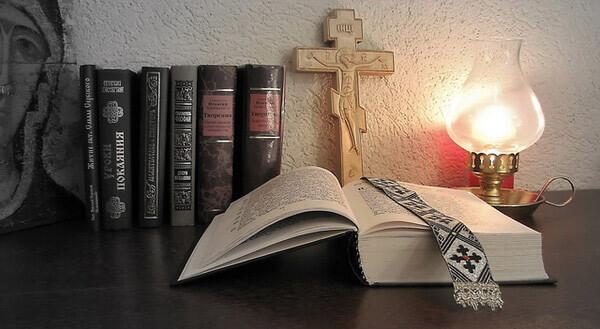
Calendar of posts and meals
Periods Monday
Tuesday
environment
Thursday
Friday
Saturday
Sunday
Great Post xerophagy
hot without oil
xerophagy
hot without oil
xerophagy
hot oil
hot oil
Springtime carnivore fish
fish
Petrov post hot without oil
fish
xerophagy
fish
xerophagy
fish
fish
Year of the carnivore xerophagy
xerophagy
Dormition fast
from August 14 to August 27, xerophagy
hot without oil
xerophagy
hot without oil
xerophagy
hot oil
hot oil
Autumn carnivore xerophagy
xerophagy
The morn-
Vienna post
from 28 November to 6 January to 19 December
hot without oil
fish
xerophagy
fish
xerophagy
fish
fish
20 Dec — 1 Jan
hot without oil
hot oil
xerophagy
hot oil
xerophagy
fish
fish
January 2-6
xerophagy
hot without oil
xerophagy
hot without oil
xerophagy
hot oil
hot oil
Winter carnivore fish
fish
published
P. S. And remember, only by changing their consumption — together we change the world! ©
Join us in Facebook , Vkontakte, Odnoklassniki
Source: bogoslovy.ru/post.htm
“What is lent? It is a precious gift to us of our Savior, Who Himself fasted for forty days and nights, neither eating nor drinking; the gift is truly precious to all seekers of salvation, as martial spiritual passions. The word and example of Their Lord legalized it to Your followers,” says St. John of Kronstadt.
Great post — the most important and severe among the posts. It starts seven weeks before Easter and consists of Quadragesima (forty days) and Holy week (week before Easter).
Lent is established in imitation of the Lord Jesus Christ, postischemia in the wilderness for forty days and Holy week – in remembrance of the last days of His earthly life, suffering, death and burial. Thus, the overall continuation of lent with Passion week is 48 days.

Lent is preceded by three weeks, during which the Holy Church begins to prepare spiritually for it. The first preparatory week is “Week of the publican and the Pharisee” – called “solid week”, because there are no post on the meal. Sunday during the Liturgy the gospel is read “About the Pharisee and the publican” (LK. 18, 10-14). Through this parable the Church teaches us true humility and repentance, without which the post would be fruitless. Starting this week until the fifth week of lent, the vigil after the reading of the gospel, sung prayer that is listened to on bended knees: “Repentance, pray for me at the door...”
During the second preparatory week “the Week of the prodigal son”, Wednesday and Friday – lean. On Sunday the Liturgy is read the parable from the gospel “Of the prodigal son” (LK. 15, 11-32), which calls the lost to repent and return to the Lord, hoping for His mercy. This week and next for a couple of weeks on the vigil after the polyeleos, an sing the 136th Psalm: “by the rivers of Babylon, there we sat down, yea there...” He describes the suffering of the Jews in the Babylonian captivity and sorrow for the lost homeland, figuratively speaking – about our captivity of sin and that we must seek his spiritual Fatherland, the Heavenly Kingdom.
The third preparatory week is called “cheese-fare” or “cheese” and the national “carnival”. This week is already not eating meat. Wednesday and Friday are not lean, it is permitted to eat milk, eggs, fish, cheese, butter. The old Russian custom, on Shrove Tuesday pancakes are baked. Sunday “cheese-fare week”, respectively, the gospel reading is called “the Sunday of the last judgment” (Matt. 25. 31-46). This reading the Church calls upon sinners to repent and to do good deeds, Recalling that for all the sins we have to answer. Since the beginning of this week, within marriage, required to abstain from marital relations.
The last Sunday before lent is called “first Sunday before lent”: it ends the eating of eggs and dairy products.
The Liturgy reads the gospel part of the sermon on the mount (Matt. 6, 14-21) concerning the forgiveness of injuries to our fellowmen, without which we cannot obtain forgiveness of sins from the Heavenly Father; about fasting and about gathering treasures in heaven.
In accordance with this gospel reading, Christians ask for in this day each other for forgiveness for any resentment and seek to reconcile. Therefore, Sunday is called “forgiveness Sunday”.
The first and the last (Holy) week of the Great lent are characterized by their severity, and their worship – duration.
This is a time of special repentance, and ardent prayer. Believers usually visit daily worship of these weeks.
Under the Charter, on Monday and Tuesday of the first week established the highest degree of fasting – complete abstinence from food; the first partaking of food is allowed only on Wednesday and the second Friday after the Liturgy of the Presanctified Gifts.
In these days of xerophagy is prescribed, that is, food without oil.
Of course, for the weak, the sick, the elderly, pregnant and lactating women these requirements, with the blessing of the Confessor, weaken. Starting on Saturday of the first week, you can eat lean foods.
Fish is allowed only twice in the entire post: at the Annunciation (April 7), if the holiday does not fall on Holy week, and at the Entrance of our Lord into Jerusalem (palm Sunday). On the Saturday of Lazarus (Saturday before palm Sunday) fish allowed caviar. If you strictly follow the Charter, then the vegetable oil allowed only on Saturdays (except Saturday during Passion week) and Sundays.
FEATURE of LENTEN services – the Commission of Liturgy only on Saturdays and Sundays; Monday, Tuesday and Thursday, the Liturgy is not performed. On Wednesdays and Fridays, Liturgy of the Presanctified Gifts. The name of this service suggests that it is the communion of the Holy Gifts consecrated on the previous Sunday. In the Church – and the black vestments, and a special guard chant chants – call to repentance, to change sinful life. Constantly heard the prayer of St. Ephraim the Syrian “o Lord and master of my life...” that all worshippers make prostrations.
The first four days of lent in the evening in the Orthodox churches read the great penitential Canon of St. Andrew of Crete – inspired work, coming from the depths of a broken heart. Orthodox people will always try not to miss these services, the extraordinary power of influencing the soul.
On Friday of the first week after the Liturgy is the blessing “coliva” (boiled wheat with honey), in memory of the Holy great Martyr Theodore of Tyrone. This Saint appeared in a dream to the Bishop of Antioch Eudoxius. He revealed to him the secret order of the Emperor Julian the Apostate to sprinkle the blood of animals sacrificed to idols all edibles are commanded during the week not to buy anything on the market, and eat koliva.
The first week of Great lent dedicated to the Triumph of Orthodoxy. The celebration that was set on the final victory of the Holy Church over the iconoclastic heresy. On this day, after the Liturgy, the temple is a special rite – the rite of the triumph of Orthodoxy. This order of the Church anathematizes, that is, excommunicate from unity with the heretics, the enemies of Orthodoxy, and praise his defenders.
The second week celebrates the memory of St. Gregory Palamas. He is known as a denouncer of the heresy of Barlaam rejected the Orthodox doctrine of netwarcom light.
The third week of Great lent – veneration of the Cross. This week is celebrated the Holy Cross. For worship and spiritual reinforcement passing feat of lent the Cross removed from the altar in the middle of the Church. Following the veneration of the cross week week bears the same name, and is called Sredokresie since Wednesday lent reaches its mid-point.
The fourth week of lent offers us an example of fasting of life in the face of the monk John Climacus, author of “the ladder”.
Wednesday in the fifth week all night vigil is celebrated with the reading of the Great penitential Canon of Andrew of Crete and the life of Saint Mary. According to this feature, it is called St. Andrew's standing, or standing Mary of Egypt.
On Saturday of the same week performed the akathist to the most Holy Theotokos, which was established in gratitude for the deliverance of Constantinople from Its enemies.
The fifth week of Great lent dedicated to the glorification of the feats of St. Mary of Egypt.
Saturday before the feast of the Lord's Entrance to Jerusalem named Lazarus. On this day remember the resurrection of Lazarus that the Lord Jesus Christ as proof of His divine power and a sign of our resurrection. Lazarevo resurrection gave rise to the condemnation of the Savior to death, so from the very first centuries of Christianity was set to make the memory of this great miracle before the Passion week.
The sixth week of Great lent is called the “Week of palms”,in common parlance – palm Sunday” (or Flowering), and the celebrated “Christ's Entry into Jerusalem.” Branches of palms (palm branches) we have replaced the willows as willow informed the other branches gives a kidney. The tradition to use the fronds in this celebration has its basis in the circumstances of the event of Christ's entry into Jerusalem. Praying as though meet the invisible coming of the Lord, and greet Him as conqueror of death and hell, holding a “sign of victory” – flowering willow, with vozzrenii candles.
After palm Sunday comes the Great days, or Holy week. In the Church read the gospel of the Passion (Suffering of Christ), as He was betrayed by Judas Iscariot, was taken into custody, bichevin and crucified on the Cross. Post on this week as the first, strict (i.e. without oil). And on Great Friday – a day of universal sorrow of the crucified Savior is customary not to eat any food until the end of the liturgical rite of burial shroud of the Lord, we have special covers with the image of Christ lying in the tomb. Every day of the week has a name – Great Monday, Great Tuesday etc. during this week believers are beginning to prepare for Easter and try more often to visit the temple.
In Great Monday , the Church remembers the desiccation of the barren Fig tree, which Jesus Christ did not found the true fruit, rebuked it and cursed. The Fig tree represents not only the Assembly of the Jews, but also every soul that does not bear fruit of repentance. In addition to the discussion about the dryness of the Fig tree, the gospel is read with the parable of the unjust husbandmen who killed first the servants of his Lord, and then his son. The parable depicts the hardening of the Jews, was beaten before the prophets, and then crucified and the son of God, come to earth. Through this parable the Church teaches us not to be like these tenants, stout violating the commandments of the Apostolic and of the Lord, and thereby continuing to crucify the Son of God with your sins.
Its contents Church service of Great Tuesday borrows from the parable of the ten virgins, the talents and continue to put Great Monday story about the Second coming of Christ. These memories Holy Church teaches believers to spiritual wakefulness, especially necessary in the days of empathy to the suffering of the Lord for us; the parable of the talents encourages the use given to us powers and forces to the service of God, especially the works of mercy, which He takes as a personal merit to Yourself, as you did it to one of these brothers of Mine, you did for Me. (Matt. 25, 40).
On Holy Wednesday is celebrated the wife is a sinner, not saved for the Lord precious in the world, and condemned the avarice and betrayal of Judas.
Of all the days last week stands out Great Thursday. This day was established by the Church in remembrance of the last Supper, which Jesus Christ gathered His disciples together on the first day of the Jewish Passover. At this meal the Savior broke the bread and giving the disciples and said, take, eat; this is my Body. And he took the Cup and gave thanks, and gave it to them and said: drink from it, for this is My Blood of the New Testament, which is shed for many for the remission of sins. (Matt. 26, 26-28). So first Jesus Christ Himself established the sacrament of Communion. Maundy Thursday is also called “Clean” – the day Christians sincerely repent in the confessional with a clear conscience proceed to the Cup of the Lord.
In Great Thursday evening the temple is “the Service of Holy and saving Passion of our Lord Jesus Christ.” Believers are edified by hearing the full gospel story of the passion of Christ, extracted from the four Gospels and is divided into 12 readings.
In Holy and Great Friday Liturgy does not happen in memory that this day the Lord has sacrificed Himself. Committed only to the king's Watch. Vespers served in the third hour of the day, at the hour of death of Jesus Christ on the Cross.
At the end of this service is the shroud, which is read touching the Canon of “the crucifixion of the Lord and the lamentation of the virgin”. Worshipers kiss the shroud and put over her the gospel. The shroud is in the middle of the temple in three days, resembling those of a three-day presence of Jesus Christ in the tomb.
(This day is allowed to eat only after the end of the rite of burial shroud of the Lord.)
All the divine services of great Saturday is a touching combination of opposite feelings – of grief and joy, sorrow and joy, tears and bright jubilation.
At Vespers 15 read Proverbs (texts of Scripture). In these Proverbs contains almost all the major prophecies and types of the old Testament relating to Jesus Christ. In the Ancient Church during the reading of the Proverbs of great Saturday was celebrated by the sacrament of Baptism in order to ready to become Christians might partake of the joy of Passover together with the faithful. After the reading of the Epistle to the clergy in the altar preobrazhaetsya bright.
After the Liturgy all-night vigil before the consecrated cakes, cheese Easter, painted eggs.
Holy week ends with the celebration of Easter – the Bright resurrection of Christ. The resurrection of Jesus Christ in the flesh – the prototype of the universal resurrection of all people on the day of judgment and the promise of eternal life prepared by God for the righteous. It's a feast for those who, fulfilling the commandments of Christ in his life on earth sarasinee with Christ, leading a spiritual battle with the passions and sin. Lent is the path to the day of Christ's Resurrection and carries the meaning of crucifixion and novokracine us to Christ.

Calendar of posts and meals
Periods Monday
Tuesday
environment
Thursday
Friday
Saturday
Sunday
Great Post xerophagy
hot without oil
xerophagy
hot without oil
xerophagy
hot oil
hot oil
Springtime carnivore fish
fish
Petrov post hot without oil
fish
xerophagy
fish
xerophagy
fish
fish
Year of the carnivore xerophagy
xerophagy
Dormition fast
from August 14 to August 27, xerophagy
hot without oil
xerophagy
hot without oil
xerophagy
hot oil
hot oil
Autumn carnivore xerophagy
xerophagy
The morn-
Vienna post
from 28 November to 6 January to 19 December
hot without oil
fish
xerophagy
fish
xerophagy
fish
fish
20 Dec — 1 Jan
hot without oil
hot oil
xerophagy
hot oil
xerophagy
fish
fish
January 2-6
xerophagy
hot without oil
xerophagy
hot without oil
xerophagy
hot oil
hot oil
Winter carnivore fish
fish
published
P. S. And remember, only by changing their consumption — together we change the world! ©
Join us in Facebook , Vkontakte, Odnoklassniki
Source: bogoslovy.ru/post.htm
Vegetable soup with barley with pumpkin— delicious.
Heart surgeon Leo Bokeria: Our heart - reliable Swiss watches. But it is necessary to "wound"
